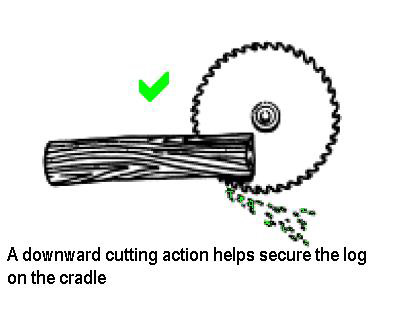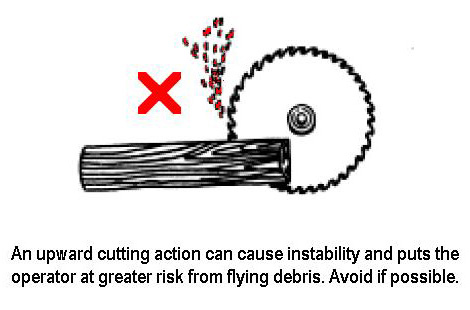Worker’s hand partially amputated by a saw
In April 2022, a worker suffered a partial amputation of his hand after it contacted a moving saw blade approximately 1m in diameter. Early investigations revealed it was a breakdown saw used to mill trees. It appears the worker was cutting a large timber log on the saw when he has accessed another blade to clear or dislodge an obstruction. Unfortunately, his hand has come into contact with the moving operational blade, causing significant amputation injuries.
Investigations into the incident are continuing.
These findings are not yet confirmed, and investigations are continuing into the exact cause.
Safety issues
Fixed plant, including breakdown saws, often have several different types of moving parts. Hazards associated with fixed plant include:
- rotating blades, shafts, pulleys, gearing, cables, sprockets, or chains
- belt run-on points, chains, or cables
- crushing or shearing points such as roller feeds and conveyor feeds
- machine components that process and handle materials or product (move, flatten, level, cut, grind, pulp, crush, break or pulverise materials)
- unexpected movement of parts operated by hydraulic, electrical, electronic or remote-control systems.
Workers who operate, maintain, repair, install, service and clean machines in all industry sectors are highly vulnerable and have a higher risk of being seriously injured or killed through inadvertent operation of equipment they are working in, on, or around.
Ways to manage health and safety
Taking steps to manage risks is a condition of doing business in Queensland. Effective risk management starts with a commitment to health and safety from those who manage the business. If an incident occurs, you'll need to show the regulator that you’ve used an effective risk management process. This responsibility is covered by your primary duty of care in the Work Health and Safety Act 2011.
Use the hierarchy of controls to help decide how to eliminate and reduce risks in your place of work. The hierarchy of controls ranks types of control methods from the highest level of protection and reliability to the lowest. It’s a step-by-step approach to eliminating or reducing risks. You must work through the hierarchy of controls when managing risks, with the aim of eliminating the hazard, which is the most effective control.
Possible control measures to prevent similar incidents
PCBUs should provide or maintain plant and systems of work that are safe and without risks to the health and safety of workers. Breakdown saws represent one of many hazards in a typical sawmill.
A breakdown saw may include:
- single circular saw
- Canadian circular saw (two blades – upper and lower)
- twin edger circular saw
- single band saw
- twin band saw
- frame saw – power ripping saw
- swing saw – individual or tractor mounted
- trolley mounted circular saw.
Mechanical hazards associated with breakdown saws, from moving parts or ejected material or slips, trips and falls include:
- cutting
- crushing
- shearing
- entanglement
- entrapment
- impact
- puncture.
Saw blades are the obvious hazard, but there is also injury risk from moving parts such as pulleys, drives, chains, and hobs. Controls for breakdown saws include:
- the area around the breakdown saw should be fenced where practical and clearly signed to restrict access, particularly where the full view of the area is restricted from the operating position (the restricted access area should be defined by risk assessment)
- when guarding is used, the person with management or control of the plant must ensure that one of the following is complied with:
- if access to the area of plant requiring guarding is not necessary during operation, maintenance or cleaning of the plant, the guarding is a permanently fixed barrier
- if access to guarded areas is necessary during operation, maintenance or cleaning, the guarding is an interlocked physical barrier that allows access to the area being guarded at times when that area does not present a risk and prevents access to that area at any other time.
- If it is not reasonably practicable to use a permanently fixed barrier or an interlocked physical barrier in accordance with the above dot points:
- then the guarding is a physical barrier that can only be altered or removed using a tool, or
- if it is also not reasonably practicable to use a physical barrier fixed in position, the guarding includes a presence-sensing safeguarding system that eliminates risk arising from the area of the plant requiring guarding when a person or any part of a person is in the area being guarded.
- flitches and pieces of timber (large and small) can be expelled from the saw. The zone where this occurs extends laterally from the centre of the saw at an angle of seven point five degrees on each side of the centreline of the saw blade, in the direction of ejection from the blade(s). Projectile barriers and/or exclusion zones should be used to protect against this risk
- consider providing and using an enclosed operator’s workstation clear of the breakdown saw (an operator’s enclosure must be designed and built to withstand the risks, such as being hit by flitches)
- where an operator is located adjacent to the breakdown saw, precautions should be taken to protect the operator from:
- constant flying sawdust and water spray
- risk of being struck by flying slivers of timber
- risk of being struck by heavy flitches
- increased risk of manual task injury if each flitch needs to be manually handled from a vertical to a horizontal alignment for cutting.
- during operation, only the operator(s) may be in the restricted area around the breakdown saw
- operators shall have a safe unobstructed view of sawing operations both on the “onside” and “offside” (convex mirrors or cameras can be used)
- the saw operator’s controls shall be capable of being secured to prevent inadvertent operation
- emergency stop devices for the saw must be placed within easy reach of the operator.


Risks can be further minimised by implementing administrative and personal protective equipment (PPE) controls. Examples include:
- installing a lock out/tag-out system to ensure the plant is isolated from its power source and cannot be operated while clearing blockages, performing maintenance or cleaning work prior to accessing any parts of the machine
- providing information, training, instruction, and supervision to workers who will use the plant that includes the development of safe work procedures in accordance with the manufacturer’s instructions
- consulting workers to obtain feedback on the plant and associated work processes and safe work procedures
- hard hats, gloves, protective footwear, eye protection, hearing protection, and high visibility clothing.
Adopting and implementing higher order controls before considering administrative or PPE controls will significantly reduce the likelihood of a similar incident occurring. The control measures you put in place should be reviewed regularly to make sure they work as planned.
More information
- Managing the risk of falls at workplaces Code of Practice 2021 (PDF, 3.9 MB)
- How to manage work health and safety risks Code of Practice 2021 (PDF, 0.65 MB)
- Sawmilling industry Health and safety guide 2017 (PDF, 2 MB)
- Guide to machinery and equipment safety (PDF, 1.46 MB)
- Manufacturing fixed plant - self assessment tool (PDF, 1.49 MB)
- Machine guarding (film)
- Isolating machinery when not in production (film)
- AS 4024 Safety of Machinery (series)
Support for people affected by a serious workplace incident
For advice and support: